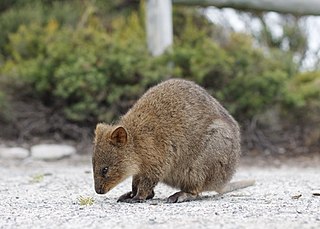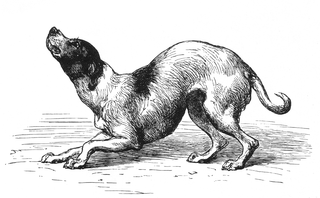
The quokka is a small macropod about the size of a domestic cat. It is the only member of the genus Setonix. Like other marsupials in the macropod family, the quokka is herbivorous and mainly nocturnal.

Comparative psychology refers to the scientific study of the behavior and mental processes of non-human animals, especially as these relate to the phylogenetic history, adaptive significance, and development of behavior. Research in this area addresses many different issues, uses many different methods and explores the behavior of many different species from insects to primates.

Animal cognition encompasses the mental capacities of non-human animals including insect cognition. The study of animal conditioning and learning used in this field was developed from comparative psychology. It has also been strongly influenced by research in ethology, behavioral ecology, and evolutionary psychology; the alternative name cognitive ethology is sometimes used. Many behaviors associated with the term animal intelligence are also subsumed within animal cognition.

Trichromacy or trichromatism is the possessing of three independent channels for conveying color information, derived from the three different types of cone cells in the eye. Organisms with trichromacy are called trichromats.

Behaviorism is a systematic approach to understanding the behavior of humans and other animals. It assumes that behavior is either a reflex evoked by the pairing of certain antecedent stimuli in the environment, or a consequence of that individual's history, including especially reinforcement and punishment contingencies, together with the individual's current motivational state and controlling stimuli. Although behaviorists generally accept the important role of heredity in determining behavior, they focus primarily on environmental events.
Dog intelligence or dog cognition is the process in dogs of acquiring information and conceptual skills, and storing them in memory, retrieving, combining and comparing them, and using them in new situations.

The mirror test—sometimes called the mark test, mirror self-recognition (MSR) test, red spot technique, or rouge test—is a behavioral technique developed in 1970 by American psychologist Gordon Gallup Jr. as an attempt to determine whether an animal possesses the ability of visual self-recognition. The MSR test is the traditional method for attempting to measure physiological and cognitive self-awareness. However, agreement has been reached that animals can be self-aware in ways not measured by the mirror test, such as distinguishing between their own and others' songs and scents.

Dog training is the application of behavior analysis which uses the environmental events of antecedents and consequences to modify the dog behavior, either for it to assist in specific activities or undertake particular tasks, or for it to participate effectively in contemporary domestic life. While training dogs for specific roles dates back to Roman times at least, the training of dogs to be compatible household pets developed with suburbanization in the 1950s.

The fat-tailed dunnart is a species of mouse-like marsupial of the Dasyuridae, the family that includes the little red kaluta, quolls, and the Tasmanian devil.

Anecdotal cognitivism is a method of research using anecdotal, and anthropomorphic evidence through the observation of animal behaviour.

Dog behavior is the internally coordinated responses of individuals or groups of domestic dogs to internal and external stimuli. It has been shaped by millennia of contact with humans and their lifestyles. As a result of this physical and social evolution, dogs have acquired the ability to understand and communicate with humans. Behavioral scientists have uncovered a wide range of social-cognitive abilities in domestic dogs.
Comparative cognition is the comparative study of the mechanisms and origins of cognition in various species, and is sometimes seen as more general than, or similar to, comparative psychology. From a biological point of view, work is being done on the brains of fruit flies that should yield techniques precise enough to allow an understanding of the workings of the human brain on a scale appreciative of individual groups of neurons rather than the more regional scale previously used. Similarly, gene activity in the human brain is better understood through examination of the brains of mice by the Seattle-based Allen Institute for Brain Science, yielding the freely available Allen Brain Atlas. This type of study is related to comparative cognition, but better classified as one of comparative genomics. Increasing emphasis in psychology and ethology on the biological aspects of perception and behavior is bridging the gap between genomics and behavioral analysis.
Discrimination learning is defined in psychology as the ability to respond differently to different stimuli. This type of learning is used in studies regarding operant and classical conditioning. Operant conditioning involves the modification of a behavior by means of reinforcement or punishment. In this way, a discriminative stimulus will act as an indicator to when a behavior will persist and when it will not. Classical conditioning involves learning through association when two stimuli are paired together repeatedly. This conditioning demonstrates discrimination through specific micro-instances of reinforcement and non-reinforcement. This phenomenon is considered to be more advanced than learning styles such as generalization and yet simultaneously acts as a basic unit to learning as a whole. The complex and fundamental nature of discrimination learning allows for psychologists and researchers to perform more in-depth research that supports psychological advancements. Research on the basic principles underlying this learning style has their roots in neuropsychology sub-processes.
Sara J. Shettleworth is an American-born, Canadian experimental psychologist and zoologist. Her research focuses on animal cognition. She is professor emerita of psychology and ecology and evolutionary biology at the University of Toronto.

Human–canine bonding is the relationship between dogs and humans. This relationship can be traced back to at least 15,000 years ago, to the Bonn-Oberkassel dog, who was found buried alongside two humans. For centuries, dogs have been considered man's best friend. This is most evident in western countries, such as the United States, where over 48% of households have a pet dog.

Theory of mind in animals is an extension to non-human animals of the philosophical and psychological concept of theory of mind (ToM), sometimes known as mentalisation or mind-reading. It involves an inquiry into whether non-human animals have the ability to attribute mental states to themselves and others, including recognition that others have mental states that are different from their own. To investigate this issue experimentally, researchers place non-human animals in situations where their resulting behavior can be interpreted as supporting ToM or not.

Pointing is a gesture specifying a direction from a person's body, usually indicating a location, person, event, thing or idea. It typically is formed by extending the arm, hand, and index finger, although it may be functionally similar to other hand gestures. Types of pointing may be subdivided according to the intention of the person, as well as by the linguistic function it serves.

Brian Hare is a professor of evolutionary anthropology at Duke University. He researches the evolution of cognition by studying both humans, our close relatives the primates, and species whose cognition converged with our own. He founded and co-directs the Duke Canine Cognition Center.













